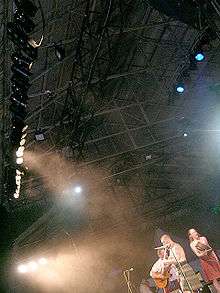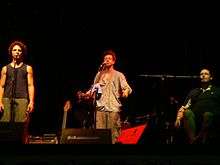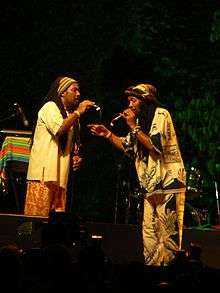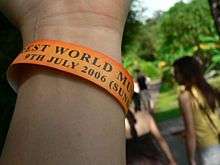Rainforest World Music Festival
| Rainforest World Music Festival Festival Muzik Hutan Hujan Sedunia | |
|---|---|
|
French Gypsy band performing during RWMF 2006 | |
| Status | Active |
| Genre | Music Festivals |
| Frequency | Annually |
| Venue | Sarawak Cultural Village |
| Location(s) | Kuching, Sarawak, Malaysia |
| Coordinates | Coordinates: 1°44′57.1″N 110°18′57.9″E / 1.749194°N 110.316083°E |
| Country | Malaysia |
| Years active | 1997 |
| Founder |
Randy Raine-Reusch Robert Basiuk Edric Ong Edgar Ong[1] |
| Sponsor | Malaysia Airlines[2] |
The Rainforest World Music Festival (often abbreviated as RWMF) is an annual three-day music festival celebrating the diversity of world music, held in Kuching, Sarawak, Malaysia, with daytime music workshops, cultural displays, craft displays, food stalls, and main-stage evening concerts. The festival has been awarded 25 of the best International Festivals by Songlines for six consecutive years; from 2010 to 2015.[3]
The festival features a wide range of performances from traditional music, to world fusion and contemporary world music. The festival emphasizes the use of traditional acoustic world instruments, although electric accompaniment instruments are common.
History


The festival was founded by Randy Raine-Reusch, a Canadian world music instrumentalist, Robert Basiuk (then marketing head of the Sarawak Tourism Board), Edric Ong, President of the Society Atelier of Sarawak, which supports traditional arts, and Edgar Ong [4] a film producer, at the Ong brothers' residence in Kuching in 1997.
The Society Atelier undertook the initial planning, financing and laid the future groundwork. When approached to assist, the Sarawak Tourism Board later took over and greatly enlarged the idea.
In the early years, Randy, Edgar Ong and Yeoh Jun Lin were responsible for selecting the international musicians who took part; they nurtured the future direction of the festival. During its fourth year, there was a bid from WOMAD to take over the festival and rename it WOMAD Borneo.
The Sarawak Tourism Board has since taken the festival to a larger audience, hence also to a more commercial level. During it first and second year, only about 400 people attended the festival. The Star reports in 2013 that the festival has bought in MYR 37 million.[5] It is reported that the festival has 60% repeat visitor ratio year-after-year.[6]
Dates of the Festival
The dates of the festival held since 2005:
| Year | Date | Attendance |
|---|---|---|
| 2005 | 8–10 July 2005 | N/A |
| 2006 | 7–9 July 2006 | 20,000[7] |
| 2007 | 13–15 July 2007 | N/A |
| 2008 | 11–13 July 2008 | 22,000[8] |
| 2009 | 10–12 July 2009 | 22,000 |
| 2010 | 9–11 July 2010 | 22,000[9] |
| 2011 | 8–10 July 2011 | N/A |
| 2012 | 13–15 July 2012 | N/A |
| 2013 | 28–30 June 2013 | 22,390[5] |
| 2014 | 20–22 June 2014 | 22,000[10] |
| 2015 | 7–9 August 2015 | 18,000[11] |
| 2016 | 5-7 August 2016[11] | TBA |
Features

The festival is held in the grounds of the Sarawak Cultural Village nestled against the base of Mount Santubong, about 35 km. north of Kuching. The festival runs workshops (mini concerts) in the afternoon followed by evening performances held on the two main stages in the village. The festival usually features from 18 to 20 bands through the weekend.
Invited performers come from Sarawak, other provinces of Malaysia, and countries near and far. Festival acts have included: Joey Ayala (Philippines - 1998), Shooglenifty (Scotland - 1999), Inka Marka (South America - 2000), Rajery (Madagascar - 2001), Black Umfolosi (Zimbabwe - 2002), Huun Huur Tu (Tuva), Cynthia Alexander (Philippines) - 2003), Te Vaka (Samoa/New Zealand - 2004), Namgar (Mongolia - 2005), Shannon (Poland - 2005, 2007), Peatbog Faeries (Scotland - 2006), Tarika Be (Madagascar - 2007), Ross Daly (Greece - 2008) and Blackbeard's Tea Party (England - 2014).[12]
The atmosphere is very relaxed. Although there are timetables for the workshops and evening performances, visitors are free to enter and leave any event at will. The daytime workshops are held inside various traditional houses in the village, where the performers and leaders of the events are often on the same floor-level as the audience, allowing them to get up close to the performers. There are also no restrictions in communicating with the performers, and the musicians themselves sometimes encourage conversation, especially if it is regarding the topic of the workshop they are running or about the traditional instruments they use. Artists are also not hidden behind barriers at the festival and can seen walking through the site throughout the duration, allowing the audience access to them at any time.
The book "Music without Borders" written by Heidi Munan, was commissioned by the Tourism Board to commemorate the 10th anniversary. With a limited publication of 5000 copies, this lavish publication featured many interviews and colour photos of the event. However it received criticism for an alleged lack of balance, with only subtle references to shortcomings and no critical commentary on possible improvements. Many contrary opinions were supposedly "censored" and anecdotes and energetic contributors from the early years omitted.
Awards and recognition
- Winner of the Heritage & Culture PATA Gold Award 2006[13]
- ASEANTA Excellence Award 2009 -Best Asean Marketing and Promotional Campaign[14]
- The BrandLaureate Country Branding Award 2012-2013[15]
- Top 25 Best International Festivals by the magazine Songlines(2010-2015)[3][16]
Food and drinks
A variety of food stalls throughout the site feature a variety of local and regional Malaysian cuisine and other Asian cuisine. Although alcohol was available for many years in a number of venues, the festival is taking steps to control its availability due to some official complaints. This has been met with mixed reviews from the public.
Security

During the 2007 festival there was a notable increase in security in and around the festival to prevent people from entering with forged tickets or causing trouble. At the entrance visitors must present their tickets and then be given an official wristband which has a security UV strip.
Metal detectors are also used to scan each visitor and backpacks and bags must be presented to the staff at the front gate to be searched. New to the additional security were guard dogs around the cultural village used to discourage the smuggling of drugs and narcotics into the festival.
Into the future
The Rainforest World Music Festival seems to be experiencing some growing pains, as it is clearly reaching the limit of its site. The festival was sold out two of the three nights in 2008, and many frustrated fans were turned away at the gate. Hotels in the region are receiving bookings a year in advance, but fortunately local guest houses are becoming more common. Although there is bus transportation to and from the site, many locals still insist on driving their own cars and end up becoming irritated with the lack of parking. Nevertheless, the festival continues to grow and attract audiences from around the world.
References
| Wikimedia Commons has media related to Rainforest World Music Festival. |
- ↑ "RAINFOREST WORLD MUSIC FESTIVAL". fest300.com. Retrieved 20 October 2015.
- ↑ Malaysia Airlines sponsors Sarawak music festivals, The Sun Daily. 15 April 2016.
- 1 2 RAINFOREST WORLD MUSIC FESTIVAL 2016, Sarawak Tourism Board. 15 April 2016.
- ↑ http://www.imdb.com/name/nm0648634
- 1 2 Music festival racks in RM37mil More than 20,000 come to the event, another success story for state and organiser, The Star. 1 August 2013.
- ↑ World music on stage in Sarawak, TTR Weekly. 11 August 2015.
- ↑ 8th Sarawak Rainforest World Music Festival, MTV Asia. 19 April 2011.
- ↑ More delights for rainforest music fest fans, The Star. 19 April 2011.
- ↑ Rainforest World Music Festival has reached a plateau, say experts, The Star. 19 April 2011.
- ↑ Unique Rainforest Festival will feature renowned international and indigenous musicians, The Star. 3 August 2015.
- 1 2 Rainforest World Music Festival 2016 from Aug 5 to 7, The Borneo Post. 20 October 2015 2015.
- ↑ "Rainforest World Music Festival". asiaexplorers.com. Retrieved 28 January 2015.
- ↑ Rainforest World Music Festival, Sarawak Tourism. 19 April 2011.
- ↑ Sarawak Tourism Board secures Aseanta award, The Star. 7 January 2009.
- ↑ Rainforest World Music Festival receives BrandLaureate Country Branding award, The Borneo Post. 31 May 2013.
- ↑ RWMF among 25 top festivals, The Star. 19 April 2011.
- Munan, H. (2007). Music Without Borders. Kuching: Sarawak Tourist Board & Marshall Cavendish Editions.
